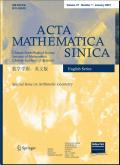具有亚二次方条件的一类受扰动分式哈密顿系统的同次解法
IF 0.8
3区 数学
Q2 MATHEMATICS
引用次数: 0
摘要
在本文中,我们考虑以下扰动分数哈密顿系统 $\left\{ {\matrix{{_tD_\infty ^\alpha {(_{ -\infty }}D_t^\alpha u(t))+ L(t)u(t) = {\nabla _u}W(t,u(t))+ {\nabla _u}G(t,u(t)),} \hfill & {t \in \mathbb{R},} \hfill \cr {u \in {H^\alpha }(\mathbb{R},{\mathbb{R}^N}),} \hfill & {}\fill \cr }}\right.$$ 其中 \(α in (1/2,1],\,L in C(\mathbb{R},{\mathbb{R}^{N \times N}})\)是对称的,不一定要求是正定的, \(W in {C^1}(\mathbb{R}\times {\mathbb{R}^{N}、\)在原点附近是局部亚二次方和局部偶数,而扰动项 \(G \in {C^1}(\mathbb{R} \times {\mathbb{R}^N},\mathbb{R})\) 也许在 u 中没有奇偶性。利用作者改进的扰动方法,我们得到了一连串的非难同次解,从而推广了之前的结果。本文章由计算机程序翻译,如有差异,请以英文原文为准。
Homoclinic Solutions for a Class of Perturbed Fractional Hamiltonian Systems with Subquadratic Conditions
In this paper, we consider the following perturbed fractional Hamiltonian systems
$$\left\{ {\matrix{{_tD_\infty ^\alpha {(_{ - \infty }}D_t^\alpha u(t)) + L(t)u(t) = {\nabla _u}W(t,u(t)) + {\nabla _u}G(t,u(t)),} \hfill & {t \in \mathbb{R},} \hfill \cr {u \in {H^\alpha }(\mathbb{R},{\mathbb{R}^N}),} \hfill & {} \hfill \cr } } \right.$$
where \(\alpha \in (1/2,1],\,\,L \in C(\mathbb{R},{\mathbb{R}^{N \times N}})\) is symmetric and not necessarily required to be positive definite, \(W \in {C^1}(\mathbb{R}\times {\mathbb{R}^N},\mathbb{R})\) is locally subquadratic and locally even near the origin, and perturbed term \(G \in {C^1}(\mathbb{R} \times {\mathbb{R}^N},\mathbb{R})\) maybe has no parity in u. Utilizing the perturbed method improved by the authors, a sequence of nontrivial homoclinic solutions is obtained, which generalizes previous results.
求助全文
通过发布文献求助,成功后即可免费获取论文全文。
去求助
来源期刊
CiteScore
1.00
自引率
0.00%
发文量
138
审稿时长
14.5 months
期刊介绍:
Acta Mathematica Sinica, established by the Chinese Mathematical Society in 1936, is the first and the best mathematical journal in China. In 1985, Acta Mathematica Sinica is divided into English Series and Chinese Series. The English Series is a monthly journal, publishing significant research papers from all branches of pure and applied mathematics. It provides authoritative reviews of current developments in mathematical research. Contributions are invited from researchers from all over the world.

 求助内容:
求助内容: 应助结果提醒方式:
应助结果提醒方式:


